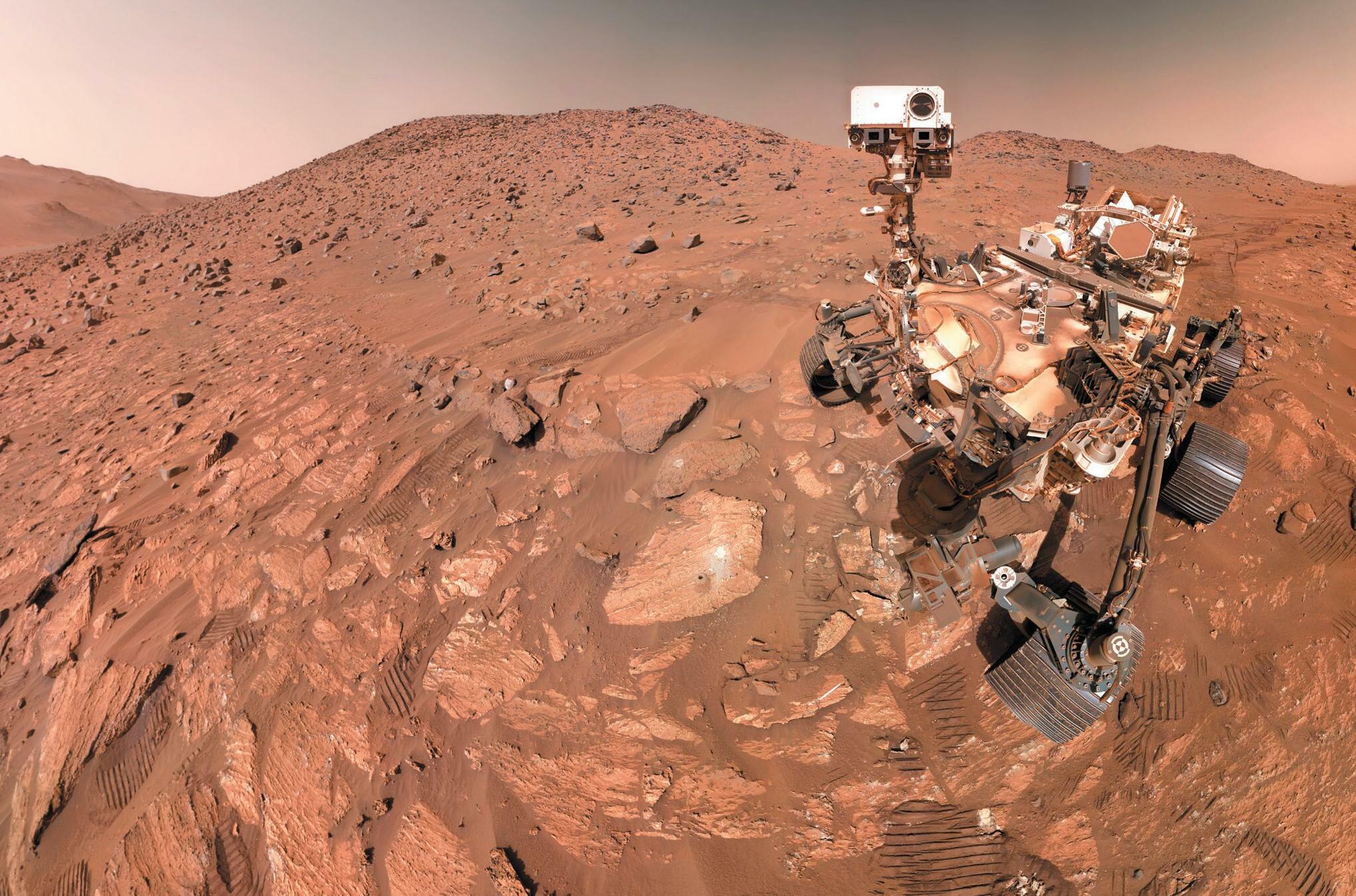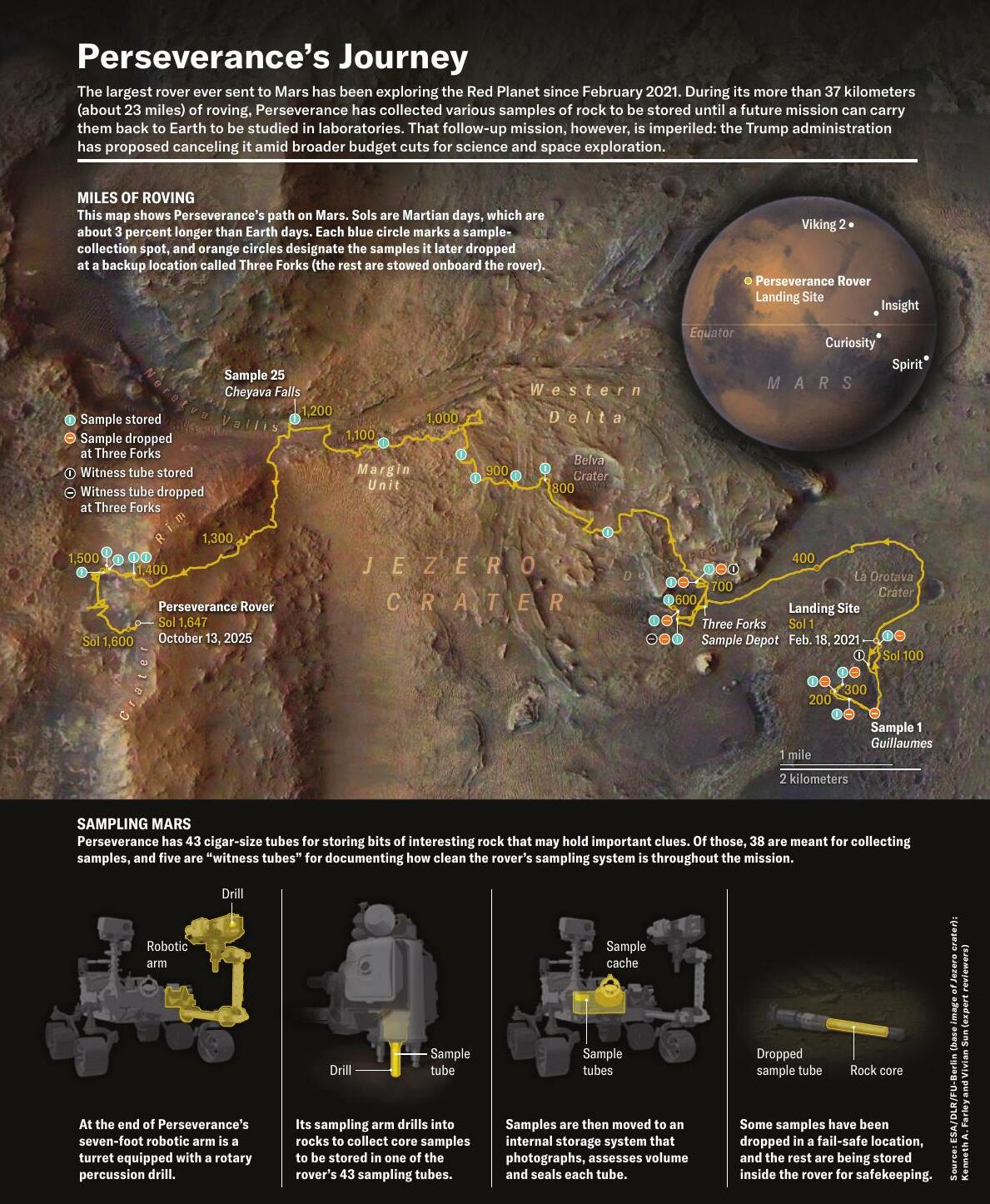Essayer OR - Gratuit
STRANDED ON MARS
Scientific American
|December 2025
NASA spent years and billions of dollars collecting Martian samples to bring home. Now it might just leave them there

NASA's Perseverance Mars rover took this selfie on Mars in July 2024. The rover stands next to a rock named Cheyava Falls, which scientists say may hold clues about whether the planet ever hosted microbial life.
RIGHT NOW ONE OF THE MOST advanced planetary explorers ever built is scouring the surface of Mars. Supported by a team of hundreds of scientists back on Earth, the Perseverance rover has traveled nearly the distance of a marathon to answer some of the biggest questions about our neighboring world: What was the planet like eons ago? Was it ever habitable? Did it host life?
One rock visited by Perseverance, called Cheyava Falls, is speckled with iron-rich minerals that might be able to answer these questions, scientists announced in September. On Earth the presence of these minerals usually means microbes that used iron in the chemical reactions essential to their metabolism once lived there. Does the same hold true on Mars? A piece of Cheyava Falls is safely tucked inside the rover's storage cache. If it can be shipped to Earth, analysis with the full range of laboratory equipment here could tell us the answer.
But Cheyava Falls's ride to our planet might have fallen through. The Perseverance rover is the first phase of a multistep mission to bring bits of Mars to Earth known as Mars Sample Return (MSR), and the next step is dangling by a thread. The Trump administration has proposed canceling the return portion of the endeavor. The mission's fate, as of press time, rests with the U.S. Congress.
 The situation has dismayed scientists who have longed to get their hands on Martian rocks. Now that Perseverance has scooped up prized samples, scientists are faced with the prospect of leaving them on Mars to languish.
The situation has dismayed scientists who have longed to get their hands on Martian rocks. Now that Perseverance has scooped up prized samples, scientists are faced with the prospect of leaving them on Mars to languish.Cette histoire est tirée de l'édition December 2025 de Scientific American.
Abonnez-vous à Magzter GOLD pour accéder à des milliers d'histoires premium sélectionnées et à plus de 9 000 magazines et journaux.
Déjà abonné ? Se connecter
PLUS D'HISTOIRES DE Scientific American
Scientific American
Will We Run Out of Rare Earth Elements?
These valuable but difficult-to-extract metals are increasingly important to modern life
1 mins
December 2025

Scientific American
Copyright Laws Can Stop Deepfakes
The U.S. should give its residents rights to their own face and voice
4 mins
December 2025

Scientific American
50, 100 & 150 Years
“The list of first-aid procedures that the medical profession encourages laypeople to undertake is short because of concern that tactics applied in ignorance may do more harm than good.
3 mins
December 2025

Scientific American
Dramatic Atmosphere
Exoplanet TOI-561 b has air where none should persist
2 mins
December 2025

Scientific American
The Mother of Depressions
Postpartum depression is a leading cause of death among new mothers. A new type of drug offers better, faster treatment
16 mins
December 2025

Scientific American
Going Rogue
A massive study may improve the prediction of dangerous rogue waves
3 mins
December 2025

Scientific American
Phages Caught Sleeping
Bacteria use hibernating viruses to immunize themselves
2 mins
December 2025
Scientific American
THE COVERT HERBARIUM OF CRYPTOGAMIC BOTANY
A century ago a father and a son labored to replicate the intricate structure of nearly eight hundred species of plants in four thousand delicate models.
1 min
December 2025

Scientific American
Are AI Chatbots Healthy for Teens?
Kids crave approval from their peers. Chatbots offer an alternative to real-life relationships, but they can come at a price
5 mins
December 2025

Scientific American
The Myth of the Designer Baby
Parents beware of any genomics firm saying it can help them with “genetic optimization” of their embryos
5 mins
December 2025
Listen
Translate
Change font size

